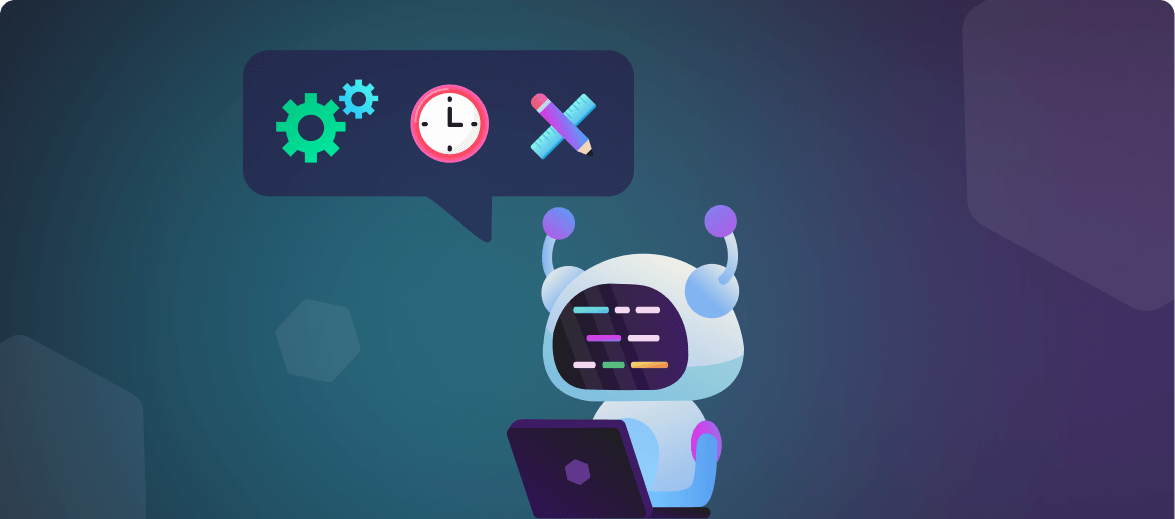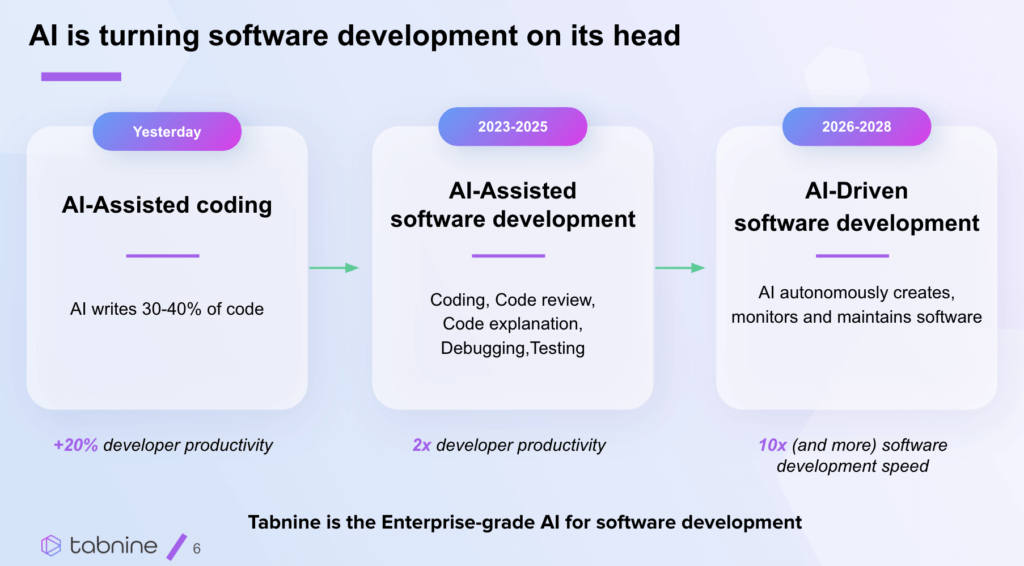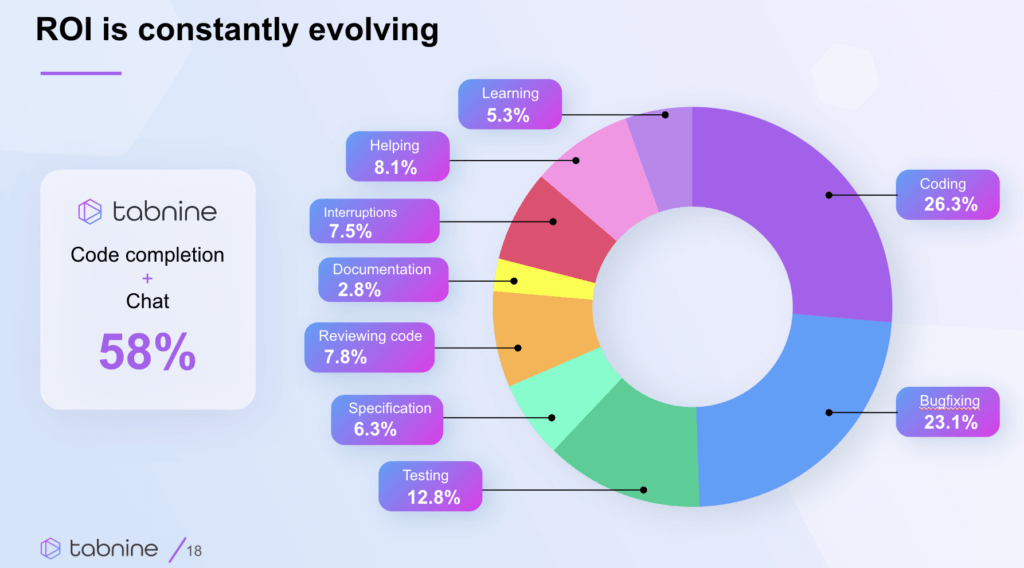Table of contents
AI for engineers: Implementation, challenges, and best practices
//
In our rapidly evolving technological landscape, AI has emerged as a crucial catalyst for growth and innovation. Recently, Brandon Jung, Tabnine’s VP Ecosystem, conducted a webinar aimed at engineers and professionals interested in leveraging AI in their organizations.
The role of an AI assistant for software
Although AI coding assistants began with integrated IDE code completion tools, they’re fast expanding beyond that, addressing a broader spectrum of developer needs. AI-driven tools can respond to intricate queries about documentation, refactoring, unit testing, and code explanation, directly within the developer’s workflow.
These capabilities signal a significant shift towards a more interactive, context-aware AI coding assistance that not only enhances productivity but also supports developers in creating superior code securely.
At its core, Tabnine remains committed to being developer-first, focusing on empowering creators with smart, trusted solutions that seamlessly integrate into their coding environment, ultimately catalyzing innovation and efficiency.
The market
The landscape of the AI-assisted software development market is pretty simple.
There are two main competitors: Tabnine and GitHub Copilot.
Insights from the Stack Overflow survey and analyses by industry experts like Gartner and Forrester reveal that while the field may appear crowded, the true measure of market leadership boils down to developer adoption and usage.
Traditionally, AI’s role in the software development lifecycle was confined to the coding phase within the IDE. Tabnine, the first to offer AI code completion capabilities, now writes between 30%–40% of our users’ code. This makes developers about 20% more productive — a number that’s been checked and proven.
Fast forward to the present: We’ve entered the era of AI-assisted software development, which goes beyond coding. As Tabnine Chat and similar innovations broaden this scope, AI is aiding in building, testing, and shaping initial requirements, with predictions suggesting that testing will soon be predominantly AI-driven — a huge leap forward in quality assurance.
The future also hints at AI not only assisting but driving key development aspects, autonomously managing software life cycles. This evolution presents the promise and challenge of building trust with developers and users as we move toward a future where AI could make software development up to ten times faster, marking a transformative shift in technology creation and usage.
Components of a generative AI solution
Three core components are crucial in generative AI:
- The user interface and design, which is important for providing developers with the right AI suggestions at the right time.
- The AI model itself, which is central to innovation, relies on open source contributions and feedback from a vast user base for continuous improvement.
- Data and security, which are fundamental, ensure the digital business is robust and the code used is safe and compliant. These components are critical for developers to leverage AI effectively in their work.
Tabnine architecture
Tabnine’s architecture is a sophisticated blend of local computing and cloud-based models, ensuring both speed and context-awareness for the developer.
Tabnine’s legacy in IDE plugin architecture extends back to its precursor, Codota, which offered Java completions. Transitioning from UI elements, the Tabnine Engine runs locally on the developer’s laptop, powered by a CPU inference engine, to provide instant, context-sensitive suggestions without the need to send data externally — thus maintaining data privacy.
The Tabnine server complements the local engine by housing larger models on powerful GPUs, which can be hosted in a SaaS environment or within a private data center. This dual structure offers tailored suggestions, from quick fixes to more in-depth advice in chat form, by leveraging multiple models simultaneously. The server’s infrastructure, supported by a global backbone across Amazon and Google platforms, ensures the delivery of the right suggestion at the right time. This intricate architecture exemplifies Tabnine’s commitment to a seamless, secure, and personalized coding experience.
The current state of AI models
The AI model ecosystem is defined by four main aspects: source openness, modality, size, and training data.
Closed-source models from major AI players tend to be large and multimodal, designed to drive platform computing, while open source models, preferred by Tabnine, are more modular and focused.
Larger models can also address more queries, but at a higher cost, which is why Tabnine uses efficient open source models optimized for specific tasks. Most importantly, the quality of a model’s output is as good as its training data, which is a cornerstone of Tabnine’s development philosophy, ensuring our AI solutions are both high-performing and trustworthy.
Data security and compliance
Brandon covered the topic of data within AI platforms, which is a trifecta of security, compliance, and customization.
Tabnine stands firm on the principle of never training on user code, thus ensuring data security. We guarantee that your code remains confidential, with deployment options that include complete isolation within managed virtual private clouds (VPC) or on-premises setups for those requiring stringent control.
On the compliance front, Tabnine commits to training models exclusively on permissively licensed open source code. This approach is the only way to ensure that the suggestions provided by the AI are compliant and free from proprietary or restricted code that could cause legal issues.
Customization is another area where Tabnine shines, adapting to a user’s unique coding style and preferences across various IDEs and version control systems (VCS). This flexibility allows Tabnine to support all knowledge management systems without locking users into a specific technology stack. This approach ensures that developers can maintain their preferred workflows while benefiting from Tabnine’s AI-powered insights, making the platform both versatile and user-centric.
Use cases and metrics
The real ROI in software development is anchored in productivity gains. Studies by NTT, Accenture, and CIT have shown that Tabnine can increase productivity by an average of 17.5%, a significant uplift from just integrating a simple plugin into the IDE.
The introduction of Tabnine Chat, even in its early stages, has expanded the tool’s impact to more areas, with initial figures indicating a productivity boost of 58%. This is particularly evident in areas like testing, documentation, and understanding complex codebases, suggesting a potential to double developer productivity.
This trend is promising for tasks developers often find tedious, like writing unit tests. Tabnine not only improves efficiency but also transforms the user experience, as evidenced by customer feedback revealing new and unexpected use cases weekly. Tabnine Chat is becoming a tool that not only automates tasks but also helps developers better comprehend and work with their code, promising a continuous and exciting evolution of productivity enhancement.
Q&A
During the Q&A part of the webinar, Brandon responded to several questions:
Does Tabnine include security detection fixes like CVEs vulnerability best practices?
While Tabnine can assist in improving security practices, it’s not designed to replace dedicated security tools. It’s important to continue using specialized tools for detecting CVEs and vulnerabilities. Tabnine complements but does not substitute these tools.
As you train Tabnine on good secure code, will it help write better secure code?
Yes, training on secure code will help Tabnine assist in writing more secure code. However, generative AI isn’t deterministic, so it should be used as an adjunct to traditional tools and processes, ensuring all code is reviewed and tested as rigorously as any other.
How do you convince developer colleagues to try AI assistance?
Tabnine’s unique appeal is that it doesn’t require team-wide adoption; individuals can use it independently. Senior developers, often skeptical, may find customized models more valuable as they help junior developers code in alignment with the team’s best practices, thereby reducing the review burden on senior team members.
Does Tabnine integrate with SQL IDEs and assist with database migrations and data warehousing?
Tabnine does support SQL and can integrate with certain SQL IDEs, although it may vary depending on the specific IDE in question. While it can aid with database migrations, it’s not a standalone solution and should be used in conjunction with expert oversight.
These responses underscore Tabnine’s role as a complementary tool in the developer’s arsenal, enhancing productivity without replacing the need for specialized software and expert review.
Try Tabnine for yourself today or contact us to learn how we can help accelerate your software development.









